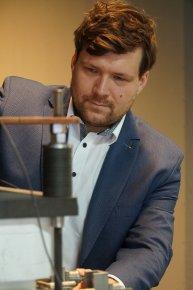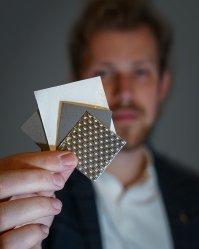High-temperature co-electrolyser for fuel synthesis

Arkadiusz Szczęśniak, PhD, during the award ceremony of the National Centre for Research and Development grants within the programme LIDER 13
The Warsaw University of Technology has been developing the technology of carbonate fuel cells for years. Another step in WUT scientists’ research is the development of a co-electrolyser for production of high quality synthetic gas.
The team of scientists from the Faculty of Power and Aeronautical Engineering has been working on MCFCs for years (Molten Carbonate Fuel Cell). – We continue the work initiated by global concerns such as Ansaldo Fuel Cell or research centres like Hanbat University, but we significantly enhance production processes of fuels and stack constructions, thanks to which we do not depend on anyone – emphasises a doctoral candidate, Aliaksandr Martsinchyk, MSc.
Step by step
– In the course of completion of many research projects, we have gained knowledge how to make MCFCs, but also how to reuse them. In the meantime, we learn to mass produce cells with printing methods. We have also perfected their structure – explains Arkadiusz Szczęśniak, PhD, who has been studying fuel cells since the beginning of his scientific career.
Within the project ”TENNESSEE”, performed with the company Tauron, the WUT team built a device for the power plant in Łaziska Górne. They used cells to absorb CO2 from exhaust gases, which allowed them to improve the parameters of the power-to-gas installation.
New development options
– When we developed carbonate fuel cells on a precommercial scale, we concluded that the next use of our technology could be synthesis of fuel directly from water, CO2 and electrical energy – says Arkadiusz Szczęśniak, PhD.
– So far we worked with fuel cells to which we supplied hydrogen and generated electrical energy. We wanted to check if the same cell, after some modifications, may work in the opposite direction, i.e., we supply water vapour and CO2 and obtain fuel – he explains.
This pattern was proved in the project ”Development and studies of a molten carbonates electrolyser (MCE)”, which received funding in the competition ”ENERGYTECH-1 Impulse” within the programme completed at WUT ”Excellence initiative – research university” (IDUB).
And it started with one cell
– On the basis of preliminary research results, we decided to repeat the solution but not as a single cell but create a stack of cells connected parallel. Thus the project COYOTE was born, along with the application to the LIDER 13 programme of the National Centre for Research and Development, which provides us with support – says Arkadiusz Szczęśniak, PhD, project leader.
Within the COYOTE project, the team consisting also of: Aliaksandr Martsinchyk, MSc, Olaf Dybiński, MSc, Pavel Shuhayeu, MSc, Professor Jarosław Milewski, Jakub Skibiński, PhD and Kamil Futyma, PhD, will develop the first Polish device for fuel synthesis – MCE co-electrolyser (Molten Carbonate Electrolysis). With the use of CO2 and water, a synthetic gas will be created for further conversion to synthetic fuels, i.e., fuels that do not contain pollution in the form of sulphur compounds, nitrides or particulates. This will increase the share of RES in energy generation and as a result, limit CO2 from the power generation sector.
This is also very important in view of the EU ban on selling combustion cars from 2035 on. The technology allows to produce the same fuel but in an emission-free way.
– At present we are building numerical tools. We want to prepare models, make simulations to check the operation of our stack – explains Arkadiusz Szczęśniak, PhD. – The next step will be its construction. First, all external elements, then we’ll add the active ones, put everything together and check how it works. If the tests are successful, the last stage will be to prepare documentation how to do it on a bigger scale – he adds.
How does the device work? – We have stored separated CO2 and water vapour. Such a mixture is put into a co-electrolyser which is powered with electricity from a renewable source (e.g., solar energy), which causes conversion of water to hydrogen and of CO2 to carbon oxide, which may be then used in reactions of fuel synthesis – explains Aliaksandr Martsinchyk, MSc.
Constant search
Co-electrolysis is the first step of fuel synthesis, the next is directing the created gas to the Fisher-Tropsch reactor. This concept, abbreviated to Hyflow, got the third place in Tech-Athon organised at WUT.
– The MCE co-electrolyser we are building is a basic device. Hyflow is the next step – says Arkadiusz Szczęśniak, PhD.
At the same time, scientists are looking for other solutions, which may optimise the operation of the device. – In the competition ”YOUNG PW” completed within the IDUB programme, we were awarded three grants for cell-related projects. One of them concentrates on the same device as the co-electrolyser but working under pressure – says Aliaksandr Martsinchyk, MSc.
In another project completed within the IDUB competition ”ENERGYTECH-2 Power” Olaf Dybiński, MSc, proved the possibility of using liquid alcohol-based biofuels to power an MCFC. Such solution ensures very high energy density and is the next step towards increasing the competitiveness of the MCFC technology and implementing it on a large scale on the energy source market. On the basis of the conclusions, an application was made in the National Centre for Research and Development Lider 14 competition to develop an MCeFC device (Molten Carbonate e-Fuel Cell), generating electrical energy and heat from CO2-neutral liquid e-fuels. Project leader will be Olaf Dybiński, MSc.
Project ”Development of an MCE co-electrolyser for fuel synthesis” (COYOTE) is performed from June 2023 and will last three years.










